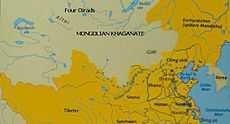Öljei Temür Khan
| Öljei Temür Khan | |||||
|---|---|---|---|---|---|
| Khagan of the Mongols | |||||
| Reign | 1408–1412 | ||||
| Coronation | 1408 | ||||
| Predecessor | Gulichi | ||||
| Successor | Delbeg | ||||
| |||||
| House | Borjigin (Post-Imperial Mongolia) | ||||
| Father | Elbeg Nigülesügchi Khan | ||||
| Born |
1379 Mongolia | ||||
| Died |
1412 Mongolia | ||||
| Religion | Islam | ||||

Öljei Temür Khan, Bunyashir Khan (full name: Bunyashiri, died 1412) was the Mongol khan of the Post-Imperial Mongolia. He was a son of Elbeg Nigülesügchi Khan and younger brother of Gün Temür Khan. He was one of the Borjigin princes, such as Tokhtamysh and Temur Qutlugh, backed by Tamerlane to seize the throne.
Early life
Tsagaan Sechen tells that Bunyashiri (Buyanshir) was born in 1379.[1] Twenty years after his birth, his father, Elbeg, was murdered by the Oirats led by Bahamu and Guilichi. In 1402, his older brother, Gün Temür Khan was killed by Örüg Temür Khan Guilichi in the struggle for the crown.
Conversion to Islam
Due to internal struggles of the Mongols, the infant prince, Bunyashiri, fled to Beshbalik where Timur's governor stationed. Timur ordered his governor to receive him kindly. Bunyashiri converted to Islam while he stayed at the court of Timur in Samarkand, thus making Öljei Temür Khan one of the very notable converts to Islam from the house of Kublai Khan.[2]
Demise of Northern Yuan
However, Örüg Temür Khan Guilichi’s victory was short lived when he made several grave miscalculation. The first was when he replaced Mongol Khan with Tatar Khan, alienating many other Mongol clans that were not Tatar. The second one was that Örüg Temür Khan Guilichi abolished the name Yuan, because he needed to show Ming Dynasty friendly gesture as Ming’s subordinate so that he could consolidate his power and conquer other Mongol clans. This move was totally unacceptable to most if not all Mongols who wanted to recover their former glory and retake China proper by defeating Ming Dynasty, which originally begun as rebellions against the Yuan Dynasty.
Rise of Bunyashiri
Taking the opportunity, Bunyashiri declared himself as the new Khan with the title of Öljei Temür (Өлзий төмөр) at Beshbalik in 1403 and most Mongol clans soon rallied on his side. Arughtai of the Asud acknowledged his suzerainty and was made chingsang (grand chancellor) of him. Oljei Temür Khan Bunyashiri's direct linkage of Genghis Khan line only further strengthened his position: though Örüg Temür Khan declared himself as Khan, his claim was not recognized by most Mongol clans. The Ming court stepped up its divide and rule tactics on Northern Yuan Mongols by dispatching a eunuch, Wan An, to help Bunyashiri.[3] Örüg Temür Khan Guilichi was soon defeated and although Guilichi’s son continued to carry on the struggle for the position of the khan all the way till his death in 1425, they were never be able to pose any serious threat to Bunyashiri’s force, whose main enemy was the Ming Dynasty.
In 1409, the Chinese court bestowed upon the Oirat leaders the title of wang, exacerbating the Mongol-Oirat conflict. Öljei Temür Khan attacked the Four Oirats and failed to subjugate his stubborn subjects.
After hearing of a new Borjigin Emperor consolidating his power over the Mongols, the Ming king, Yongle, demanded Öljei Temür Khan to submit. The Mongolian court decided to decline it and detained the Chinese envoy. Arughtai executed another Ming envoy in 1409.[4] A punitive expedition of the Ming led by Ch'iu Fu was crushed and the general and several other commanders lost their lives at the hand of Arughtai on September 23, 1409.[5]
War against Yongle Emperor

In response to the defeat of Ch'ui Fu's forces, the enraged Yongle Emperor gathered a half a million strong force to launch a decisive campaign against Öljei Temür Khan Bunyashiri. Before the battle, Öljei Temür Khan and Arughtai could not agree on a plan of action and simply moved in different directions.[6] Arughtai decided to withdraw to the east of Mongolia while Öljei Temür Khan Bunyashiri headed west and set up his ordo (palace) on the banks of the Onon River. He was suddenly forced to accept a battle in which Ming army won a sounding victory by nearly completely wiping out his entire army in 15 June 1410. Öljei Temür Khan Bunyashiri was barely able to escape with his life with only seven cavalries and his son while all the rest were lost. He was trying to reach the Chagatai Khanate where he was grown up. Capitalizing on the Khan’s mistake, the Oirat leader, Mahamud, killed him in 1412 and installed his own puppet khan, Delbeg (or Dalbag), on the throne in 1413.[7] The death of Öljei Temür Khan Bunyashiri marked the temporary decline of Borjigin line, and different Mongol clans fought each other for dominance.
| Öljei Temür Khan Died: 1412 | ||
| Regnal titles | ||
|---|---|---|
| Preceded by Örüg Temür Khan |
Khan of the Post-Imperial Mongolia 1408–1412 |
Succeeded by Delbeg Khan |
References
- ↑ Sir Henry Hoyle Howorth-History of the Mongols: The Mongols proper and the Kalmuks, p.343
- ↑ C. P. Atwood-Encyclopedia of Mongolia and the Mongol Empire, see: Northern Yuan Dynasty
- ↑ Shih-Shan Henry Tsai-Perpetual Happiness: The Ming Emperor Yongle, p.166
- ↑ Ed.Frederick W. Mote, Denis Twitchett, John King Fairbank-The Cambridge history of China: The Ming dynasty, 1368-1644, Part 1, p.226
- ↑ Shih-Shan Henry Tsai-Perpetual Happiness: The Ming Emperor Yongle, p.167
- ↑ Denis Crispin Twitchett, John King Fairbank-The Cambridge history of China, Volume 2; Volume 8, p.229
- ↑ Edward L. Dreyer-Early Ming China: a political history, 1355-1435, p.178
| ||||||||||||||||||||||